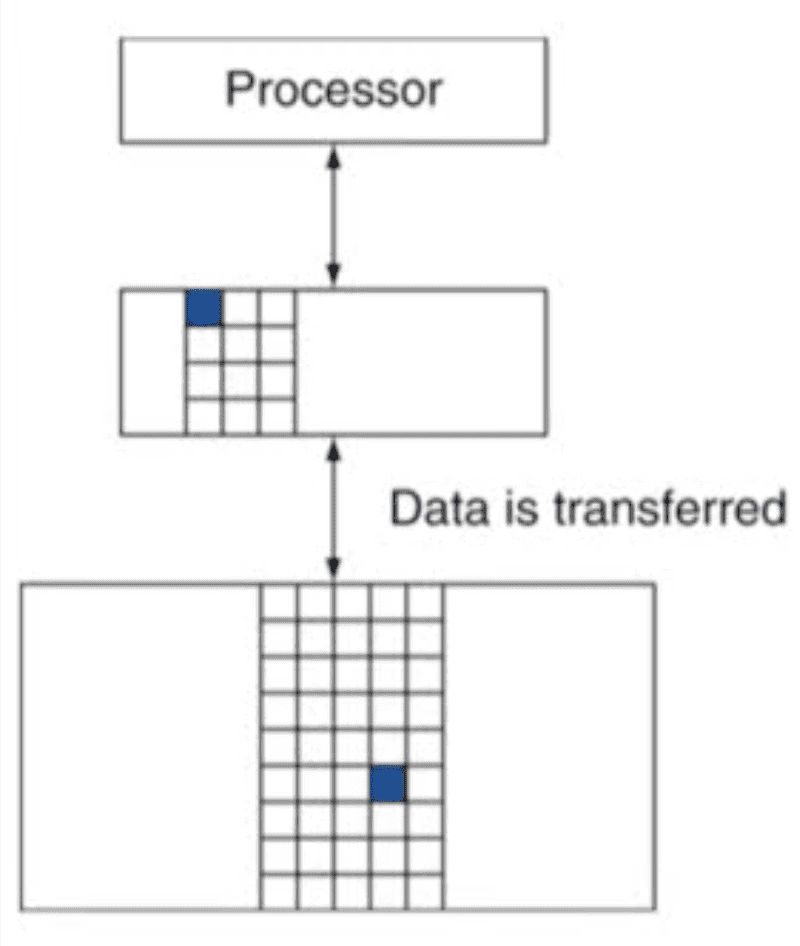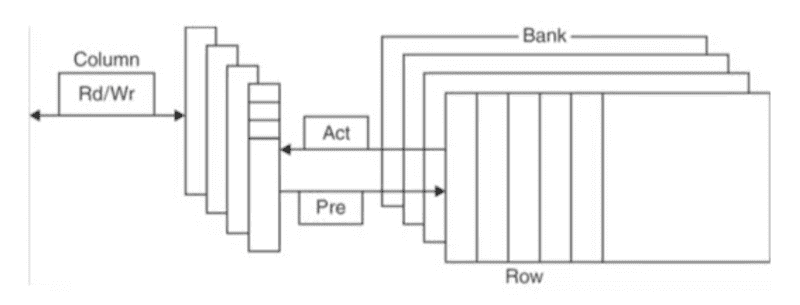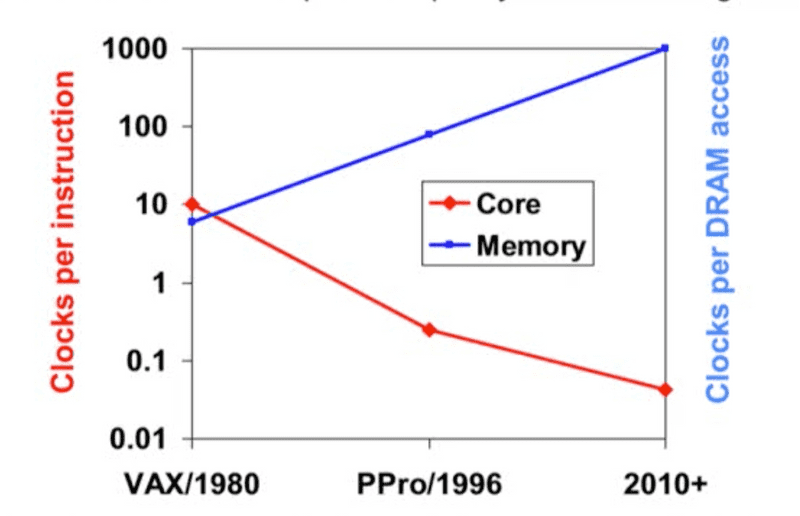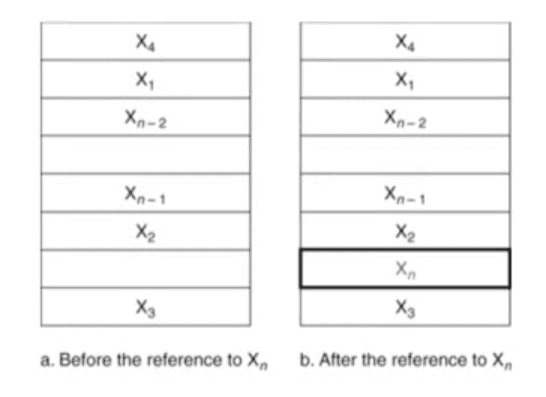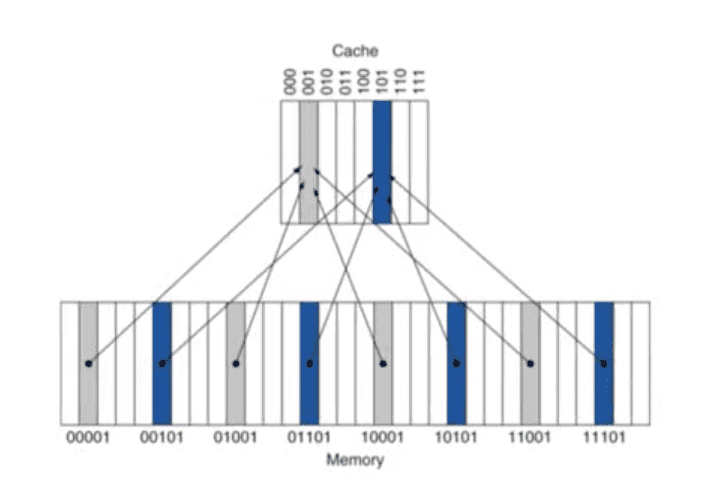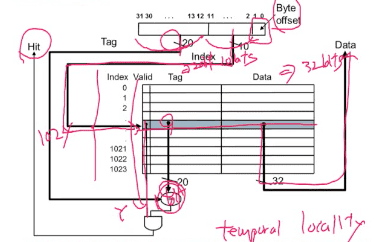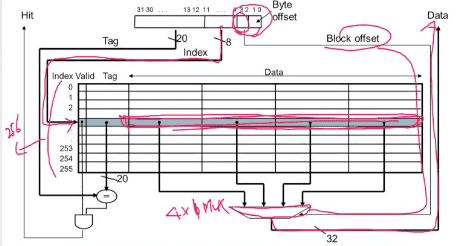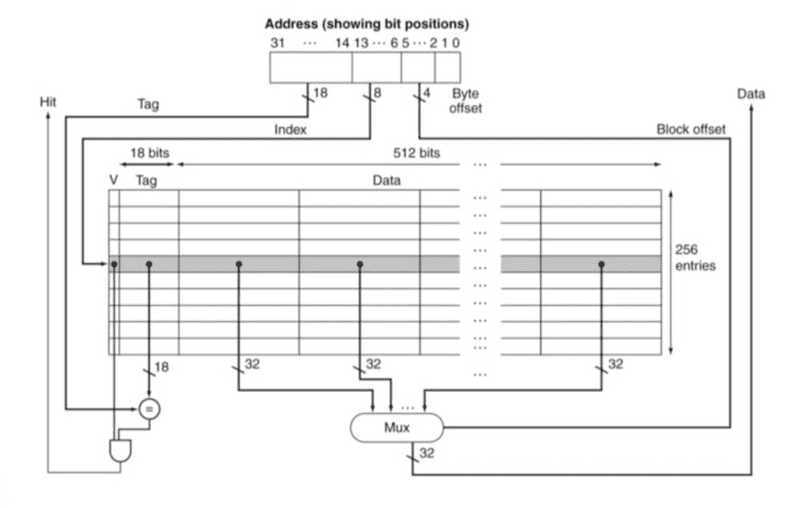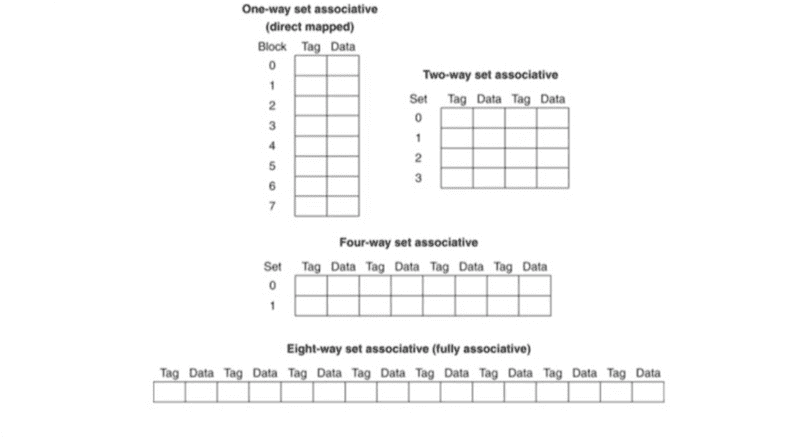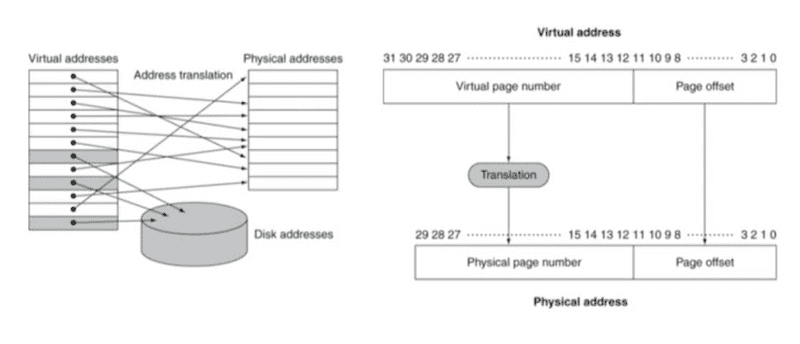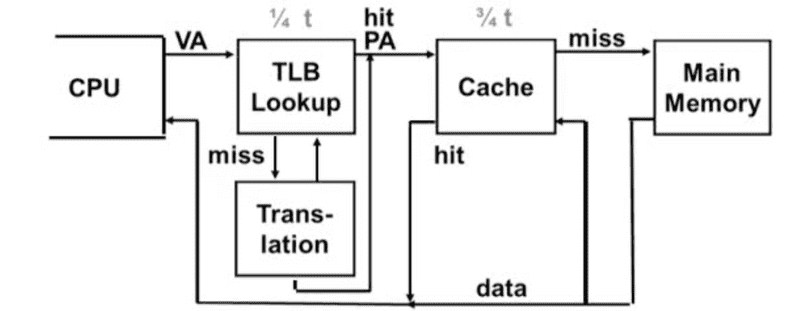[컴퓨터구조론] 5. Large and Fast: Exploiting Memory Hierachy
2020-10-04
본 글은 영남대학교 최규상 교수님의 컴퓨터 구조 강의를 듣고 작성된 글입니다.
5.1 Introduction
-
Principle of Locality
- Programs access a small proportion of their address space at any time
-
Temporal locality
- Items accessed recently are likely to be accessed again soon
- e.g., instructions in a loop, induction variables
-
Spatial locality
- Items near those accessed recently are likely to be accessed soon
- e.g., sequential instruction access, array data
-
Taking Advantage of Locality
- Memory hierarchy
- Store everything on disk
-
Copy recently accessed (and nearby) items from disk to smaller DRAM memory
- Main memory
-
Copy more recently accessed (and nearby) items from DRAM to smaller SRAM memory
- Cache memory attached to CPU
-
-
Block (aka line): unit of copying
- May be multiple words
-
If accessed data is present in upper level
-
Hit: access satisfied by upper level
- Hit ratio: hits/accesses
-
-
If accessed data is absent
-
Miss: block copied from lower level
- Time taken: miss penalty
- Miss ratio: misses/accesses = 1 - hit ratio
- Then accessed data supplied from upper level
-
-
- Characteristics of the Memory Hierarchy
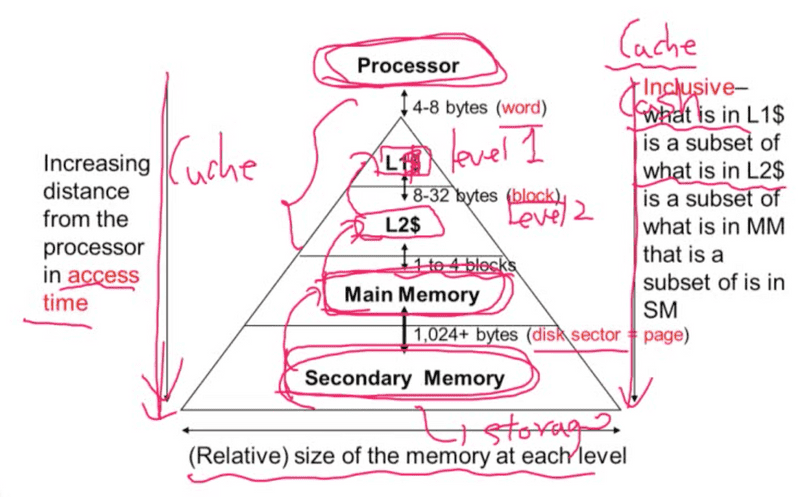
-
DRAM Technology
-
Advanced DRAM Organization
-
Bits in a DRAM are organized as a rectangular array
- DRAM accesses an entire row
- Burst mode: supply successive words from a row with reduced latency
-
Double data rate (DDR) DRAM
- Transfer on rising and falling clock edges
-
Quad data rate (QDR) DRAM
- Separate DDR inputs and outputs
-
-
DRAM Generations
- 시간이 지남에따라 가격은 낮아지고 용량은 증가하였음
-
DRAM Performance Factors
-
Row buffer
- Allows several words to be read and refreshed in parallel
-
Synchronous DRAM
- Allows for consecutive accesses in bursts without needing to send each address
- Improves bandwidth
-
DRAM banking
- Allows simultaneous access to multiple DRAMs
- Improves bandwidth
-
-
Main Memory Supporting Caches
-
Use DRAMs for main memory
- Fixed width (e.g., 1 word)
-
Connected by fixed-width clocked bus
- Bus clock is typically slower than CPU clock
-
Example cache block read
- 1 bus cycle for address transfer
- 15 bus cycles per DRAM access
- 1 bus cycle per data transfer
-
For 4-word block, 1-word-wide DRAM
- Miss penalty = 1 + 4 * 15 + 4 * 1 = 65 bus cycles
- Bandwidth = 16 bytes / 65 cycles = 0.25 B/cycle
-
- Increasing Memory Bandwidth

5.2 Memory Technologies
- Review: Major Components of a Comupter
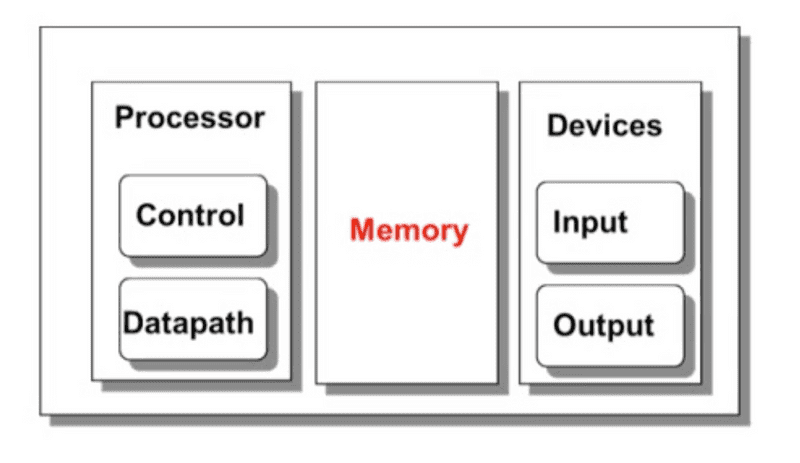
-
Memory Technology
-
Static RAM (SRAM)
- 0.5ns ~ 2.5ns, $2000 ~ $5000 per GB
-
Dynamic RAM (DRAM)
- 50ns ~ 70ns, $20 ~ $75 per GB
-
Magnetic disk (HD)
- 5ms ~ 20ms, $0.20 ~ $2 per GB
-
Ideal memory
- Access time of SRAM
- Capacity and cost/GB of disk
-
-
Processor-Memory Performance Gap
- 프로세서와 메모리의 성능 차이는 시간이 지날수록 양극화되어 왔다.
-
The "Memory Wall"
5.3 The Basics of Caches
-
Cache Memory
- Caching: A Simple First Example
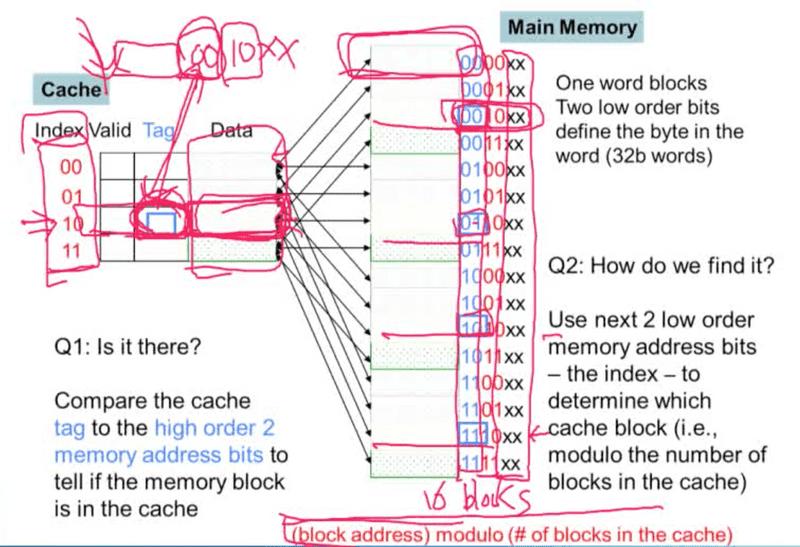
-
Direct Mapped Cache
-
Tags and Valid Bits
-
How do we know which particular block is stored in a cache location?
- Store block address as well as the data
- Actually, only need the high-order bits
- Called the tag
-
What if there is no data in a location?
- Valid bit: 1 = present, 0 = not present
- Initially 0
-
-
MIPS Direct Mapped Cache Example
-
Example: Larger Block Size
-
Multiword Block Direct Mapped Cache
-
Block Size Considerations
-
Larger blocks should reduce miss rate
- Due to spatial locality
-
But in a fixed-sized cache
-
Larger blocks -> fewer of them
- More competition -> increased miss rate
- Larger blocks -> pollution
-
-
Larger miss penalty
- Can override benefit of reduced miss rate
- Early restart and critical-word-first can help
-
-
Cache Misses
- On cache hit, CPU proceeds normally
-
On cache miss
- Stall the CPU pipeline
- Fetch block from next level of hierachy
-
Instruction cache miss
- Restart instruction fetch
-
Data cache miss
- Compleete data access
-
Write-Through
-
On data-write hit, could just update the block in cache
- But then cache and memory would be inconsistent
- Write through: also update memory
-
But makes writes take longer
-
e.g., if base CPI = 1, 10% of instructions are stores, write to memory takes 100 cycles
- Effective CPI = 1 + 0.1 * 100 = 11
-
-
Solution: write buffer
- Holds data waiting to be written to be written memory
-
CPU continues immediately
- Only stalls on write if write buffer is already full
-
-
Write-Back
-
Alternative: On data-write hit, just update the block in cache
- Keep track of whether each block is dirty
-
When a dirty block is replaced
- Write it back to memory
- Can use a write buffer to allow replacing block to be read first
-
-
Wirte Allocation
- What should happen on a write miss?
-
Alternatives for write-through
- Allocate on miss: fetch the block
-
Write around: don't fetch the block
- Since programs often write a whole block before reading it (e.g., initialization)
-
For write-back
- Usually fetch the block
-
Example: Intrinsity FastMATH
5.4 Measuring and Improving Cache Performance
-
Measuring Cache Performance
-
Components of CPU time
-
Program execution cycles
- Includes cache hit time
-
Memory stall cycles
- Mainly from cache misses
-
-
With simplifying assumptions:
Memory stall cycles = Memory accesses/Program * Missrate * Miss penalty = Instructions/program * Misses/Instruction * Miss penalty
-
-
Cache Performance Example
-
Given
- I-cache miss rate = 2 %
- D-cache miss rate = 4 %
- Miss penalty = 100 cycles
- Base CPI (ideal cache) = 2
- Load & stores are 36% of instructions
-
Miss cycles per instruction
- I-cache: 0.02 * 100 = 2
- D-cache: 0.36 * 0.04 * 100 = 1.44
-
Actual CPI = 2 + 2 + 1.44 = 5.44
- Ideal CPU is 5.44/2 = 2.72 times faster
-
-
Average Access Time
- Hit time is also important for performance
-
Average memory access time (AMAT)
- AMAT = Hit time + Miss rate * Miss penalty
-
Example
- CPU with 1ns clock, hit time = 1 cycle, miss penalty = 20 cycles, I-cache miss rate = 5%
-
AMAT = 1 + 0.05 * 20 = 2ns
- 2 cycles per instruction
-
Performance Summary
-
When CPU performance increased
- Miss penalty becomes more significant
-
Decreasing base CPI
- Greater proportion of time spent on memory stalls
-
Increasing clock rate
- Memory stalls account for more CPU cycles
- Can't neglect cache behavior when evaluating system performance
-
-
Associative Caches
-
Fully associative
- Allow a given block to go in any cache entry
- Requires all entries to be searched at once
- Comparator per entry (expensive)
-
n-way set associative
- Each set contains n entries
-
Block number determines which set
- (Block number) modulo (#Sets in cache)
- Search all entries in a given set at once
- n comparators (less expensive)
-
- Associative Cache Example

-
Spectrum of Associativity
-
Associativity Example
-
How Much Associativity
-
Increased associativity decreases miss rate
- But with diminishing returns
-
Simulation of a system with 64KB
-
D-cache, 16-word blocks, SPEC2000
- 1-way: 10.3%
- 2-way: 8.6%
- 4-way: 8.3%
- 8-way: 8.1%
-
-
- Set Associative Cache Organization
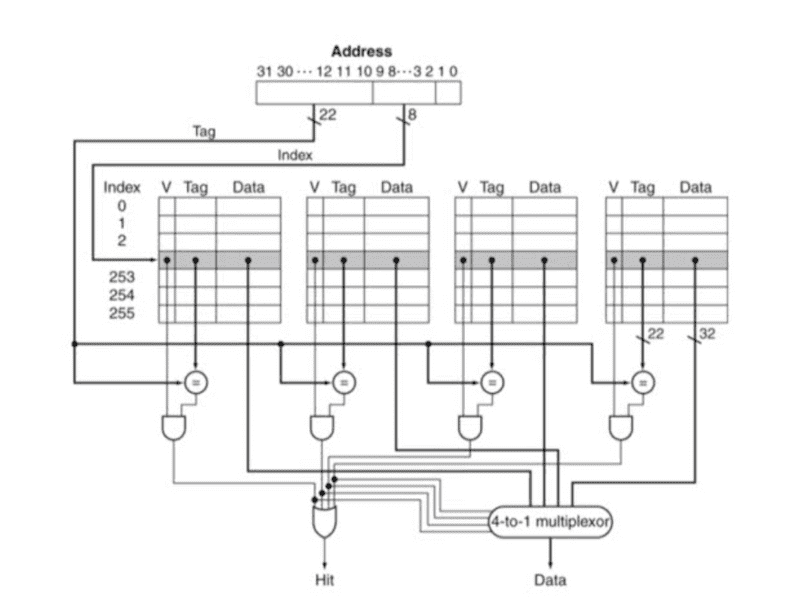
-
Replacement Policy
- Direct mapped: no choice
-
Set associative
- Prefer non-valid entry, if there is one
- Otherwise, choose among entries in the set
-
Least-recently used (LRU)
-
Choose the one unused for the longest time
- Simple for 2-way, manageable for 4-way, too hard beyond that
-
-
Random
- Gives approximately the same performance as LRU for high associativity
-
Multilevel Caches
-
Primary cache attached to CPU
- Small, but fast
-
Level-2 cache services misses from primary cache
- Larger, slower, but still faster than main memory
- Main memory services L-2 cashe misses
- Some high-end systems include L-3 cache
-
-
Multilevel Cache Example
-
Given
- CPU base CPI = 1, clock rate = 4GHz
- Miss rate/instruction = 2%
- Main memory access time = 100ns
-
With just primary cache
- Miss penalty = 100ns/0.25ns = 400 cycles
- Effective CPI = 1 + 0.02 * 400 = 9
-
Now add L-2 cache
- Access time = 5ns
- Global miss rate to main memory = 0.5%
-
Primary miss with L-2 hit
- Penalty = 5ns/0.25ns = 20cycles
-
Primary miss with L-2 miss
- Extra penalty = 500 cycles
- CPI = 1 + 0.02 * 20 + 0.005 * 400 = 3.4
- Performance ratio = 9/3.4 = 2.6
-
-
Multilevel Cache Considerations
-
Primary cache
- Focus on minimal hit time
-
L-2 cache
- Focus on low miss rate to avoid main memory access
- Hit time has less overall impact
-
Results
- L-1 cache usually smaller than a single cache
- L-1 block size smaller than L-2 block size
-
-
Interactions with Advanced CPUs
-
Out-of-order CPUs can execute instructions during cache miss
- Pending store stays in load/store unit
-
Dependent instructions wait in reservation stations
- Independent instructions continue
-
Effect of miss depends on program data flow
- Much harder to analyes
- Use system simulation
-
-
Interactions with Software
-
Misses depend on memory access patterns
- Algorithm behavior
- Compiler optimization for memory access
-
5.6 Virtual Machines
- pass
5.7 Virtual Memory
-
Virtual Memory
-
Use main memory as a "cache" for secondary (disk) storage
- Managed jointly by CPU hardware and the operating system (OS)
-
Programs share main memory
- Each gets a private virtual address space holding its frequently used code and data
- Protected fro other programs
-
CPU and OS translate virtual addresses to phsyical addresses
- VM "block" is called a page
- VM translation "miss" is called a page fault
-
-
Address Translation
-
Virtual Addressing with a Cache
- Thus it takes an extra memory access to translate a VA to a PA

- This makes memory (cache) accesses very expensive (if every access was really two accesses)
- The hardware fix is to use a Translation Lookaside Buffer (TLB) - a small cache that keeps track of recently used address maapings to avoid having to do a page table lookup
- Thus it takes an extra memory access to translate a VA to a PA
-
Page Fault Penalty
-
On page fault, the page must be fetched from disk
- Takes millions of clock cycles
- Handled by OS code
-
Try to minimize page fault rate
- Fully associative placement
- Smart replacement algorithms
-
-
Page Tables
-
Stores placement information
- Array of page table entries, indexed by virtual page number
- Page table register in CPU points to page table in physical memory
-
If page is present in memory
- PTE stores the physical page number
- Plus other status bits (referenced, dirty, ...)
-
If page is not present
- PTE can refer to location in swap space on disk
-
-
Two Programs Sharing Physical Memory
- Translation Using a Page Table

- Mapping Pages to Storage
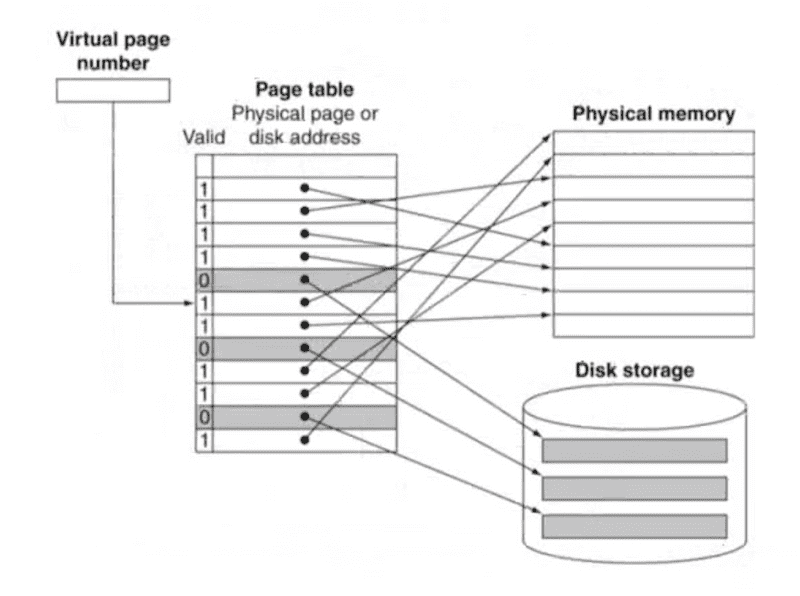
-
Replacement and Writes
-
To reduce page fault rate, prefer least-recently used (LRU) replacement
- Reference bit (aka use bit) in PTE set to 1 on access to page
- Periodically cleared to 0 by OS
- A page with reference bit = 0 has not been used recently
-
Disk writes take millions of cycles
- Block at once, not individual locations
- Write through is impractical
- Use write-back
- Dirty bit in PTE set when page is written
-
-
Fast Translation Using a TLB
-
Address translation would appear to require extra memory references
- One to access the PTE
- Then the actual memory access
-
But access to page tables has good locality
- So use a fast cache of PTEs within the CPU
- Called a Translation Look-aside Buffer (TLB)
- Typical: 16-612 PTEs, 0.5-1 cycle for hit, 10-100 cycles for miss, 0.01%-1% miss rate
- Misses could be handled by hardware or software
-
-
-
A TLB miss - is it a page fault or merely a TLB miss?
-
If the page is loaded into main memory, then the TLB miss can be handled (in hardware or software) by loading the translation information from the page table into the TLB
- Takes 10's of cycles to find and load the translation info into the TLB
-
If the page is not in main memory, then it's a true page fault
- Takes 1,000,000's of cycles to service a page fault
-
- TLB misses are much more frequent than true page faults
-
- Fast Translation Using a TLB
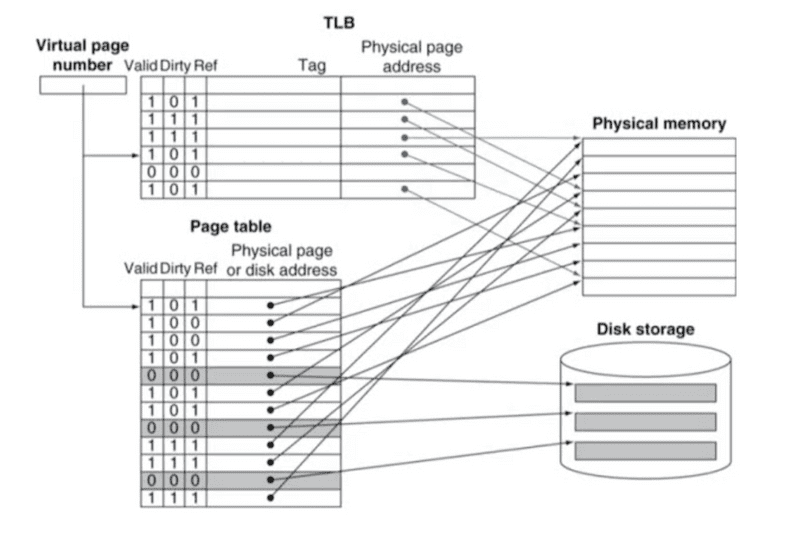
-
TLB Misses
-
If page is in memory
- Load the PTE from memory and retry
-
Could be handled in hardware
- Can get complex for more complicated page table structures
-
Or in software
- Raise a special exception, with optimized handler
-
If page is not in memory (page fault)
- OS handles fetchiing the page and updating the page table
- Then restart the faulting instruction
-
-
TLB Miss Handler
-
TLB miss indicates
- Page present, but PTE not in TLB
- Page not preset
-
Must recognize TLB miss before destination register overwritten
- Raise exception
-
Handler copies PTE from memory to TLB
- Then restarts instruction
- If page not present, page fault will occur
-
-
Page Fault Handler
- Use faulting virtual address to find PTE
- Locate page on disk
-
Choose page to replace
- If dirty, write to disk first
- Read page into memory and update page table
-
Make process runnable again
- Restart from faulting instruction
-
TLB and Cache Interaction
-
Memory Protection
-
Different tasks can share parts of their virtual address spaces
- But need to protect against errant access
- Requires OS assistance
-
Hardware support for OS protection
- Privileged supervisor mode (aka kernel mode)
- Privileged instructions
- Page tables and other state information only accessible in supervisor mode
- System call exception (e.g., syscall in MIPS)
-
5.8 A Common Framework for Memory Hierarchies
-
The Memory Hierarchy
-
Common principles apply at all levels of the memory hierarchy
- Based on notions of caching
-
At each level in the hierarchy
- Block placement
- Finding a block
- Replacement on a miss
- Write policy
-
-
Block Placement
-
Determined by associativity
-
Direct mapped (1-way associative)
- One choice for placement
-
n-way set associative
- n choices within a set
-
Fully associative
- Any location
-
-
Higher associativity reduces miss rate
- Increases complexity, cost, and access time
-
-
-
Hardware caches
- Reduce comparisons to reduce cost
-
Virtual memory
- Full table lookup makes full associativity feasible
- Benefit in reduced miss rate
-
-
Replacement
-
Choice of entry to replace on a miss
-
Least recently used (LRU)
- Complex and costly hardware for high associativity
-
Random
- Close to LRU, easier to implement
-
-
Virtual memory
- LRU approximation with hardware support
-
-
Wirte Policy
-
Write-through
- Update both upper and lower levels
- Simplifies replacement, but may require write buffer
-
Write-back
- Update upper level only
- Update lower level when block is replaced
- Need to keep more state
-
Virtual memory
- Only write-back is feasible, given disk write latency
-
-
Sources of Misses
-
Compulsory misses (aka cold start misses)
- First access to a block
-
Capacity misses
- Due to finite cache size
- A replaced block is later accessed again
-
Conflict misses (aka collision misses)
- In a non-fully associative cache
- Due to competition for entries in a set
- Would not occur in a fully associative cache of the same total size
-
- Cache Design Trade-offs
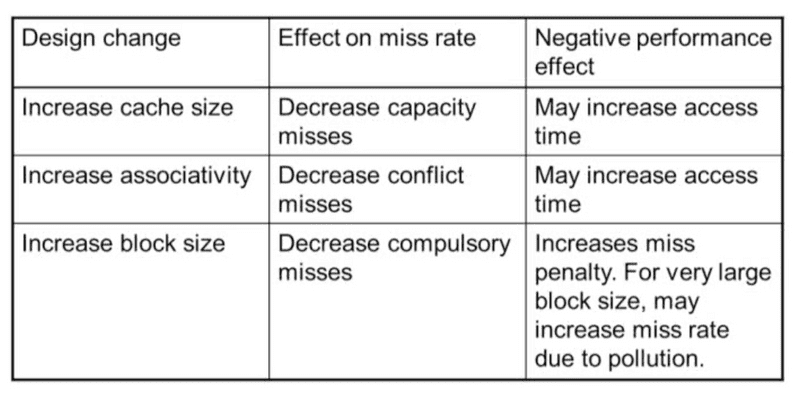
5.9 Using a Finite State Machine to Control A Simple Cache
-
Cache Control
- Interface Signals
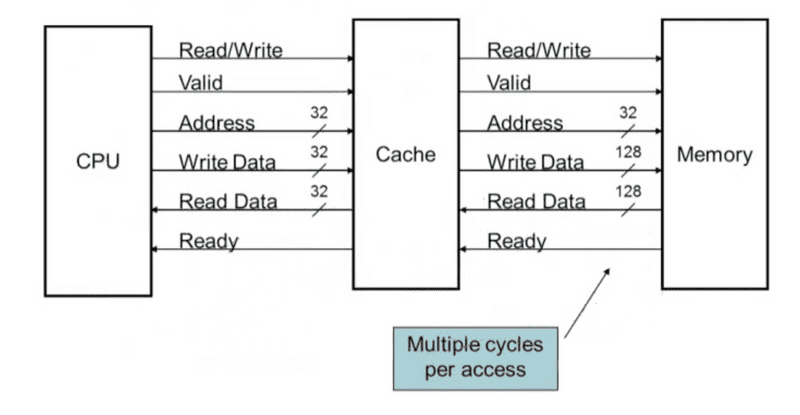
-
- Use an FSM to sequence control steps
-
Set of states, transition on each clock edge
- State values are binary encoded
- Current state stored in a register
- Next state = fn(current state, surrent inputs)
- Control output signals = f0(current state)
- Cache Controller FSM
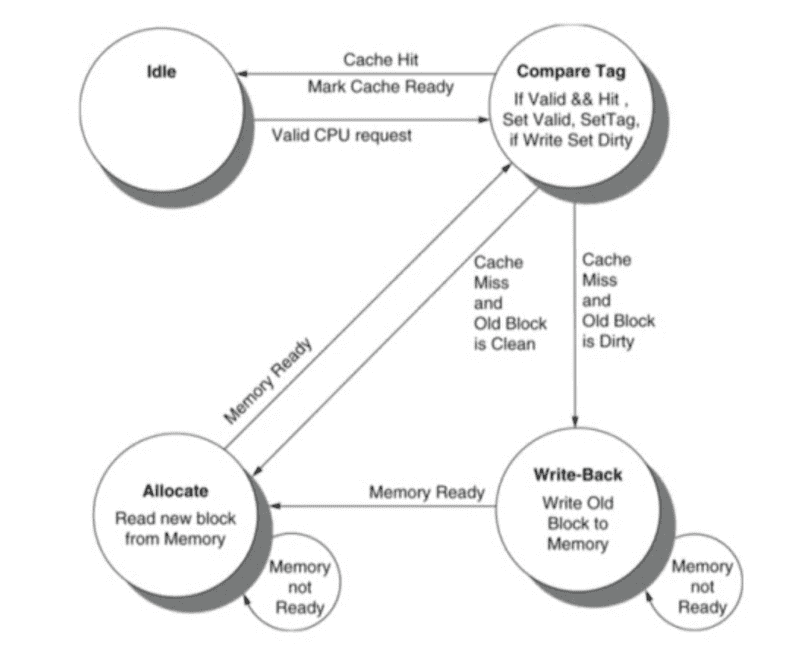
5.10 Parallelism and Memory Hierarchies: Cache Coherence
-
Cache Coherence Problem
-
Coherence Defined
- Informally: Reads return most recently written value
-
Formally:
- P writes X; P reads X (no intervening writes) -> read returns written value
-
P1 writes X; P2 reads X (sufficiently later) -> read returns written value
- c.f. CPU B reading X after step 3 in example
-
P1 writes X, P2 writes X -> all processors see writes in the same order
- End up with the same final value for X
-
Cache Coherence Protocols
-
Operations performed by caches in multiprocessors to ensure coherence
-
Migration of data to local caches
- Reduces bandwidth for shared memory
-
Replication of read-shared data
- Reduces contention for access
-
-
Snooping protocols
- Each cache monitors bus reads/writes
-
Directory-based protocols
- Caches and memory record sharing status of blocks in a directory
-
-
Invalidating Snooping Protocols
-
Memory Consistency
-
When are writes seen by other processors
- "Seen" means a read returns the written value
- Can't be instantaneously
-
Assumptions
- A write completes only when all processors have seen it
- A processor does not reorder writes with other accesses
-
Consequence
- P writes X then writes Y -> all processors that see new Y also see now X
- Processors can reorder reads, but not writes
-
5.13 The ARM Cortex-A8 and Intel Core i7 Memory Hierarchies
- pass
5.14 Going Faster: Cache Blocking and Matrix Multiply
- pass
5.15 Fallacies and Pitfalls
-
Pitfalls
-
Byte vs. word addressing
-
Example: 32-byte direct-mapped cache, 4-byte blocks
- Byte 36 maps to block 1
- Word 36 maps to block 4
-
-
Ignoring memory system effects when writing or generating code
- Example: iterating over rows vs. columns of arrays
- Large strides result in poor locality
-
In multiprocessor with shared L2 or L3 cache
- Less associativity than cores results in conflict misses
- More cores -> need to increase associativity
-
Using AMAT to evaluate performance of out-of-order processors
- Ignores effect of non-blocked accesses
- Instead, evaluate performance by simulation
-
Extending address range using segments
- E.g., Intel 80286
- But a segment is not always big enough
- Makes address arithmetic complicated
-
Implementing a VMM on an ISA not designed for virtualization
- E.g., non-privileged instructions accessing hardware resources
- Either extend ISA, or require guest OS not to use problematic instructions
-
5.16 Concluding Remarks
-
Concluding Remarks
-
Fast memories are small, large memories are slow
- We really want fast, large memory
- Caching gives this illusion
-
Principle of locality
- Programs use a small part of their memory space frequently
-
Memory hierarchy
- L1 cache <-> L2 cache <-> ... <-> DRAM memory <-> disk
- Memory system design is critical for multiprocessors
-
